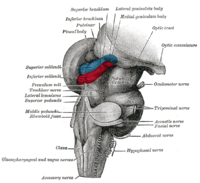
Photo from wikipedia
Inhibitory projections from the visual sector of the thalamic reticular nucleus to the lateral geniculate nucleus complete the earliest feedback loop in the mammalian visual pathway and regulate the flow… Click to show full abstract
Inhibitory projections from the visual sector of the thalamic reticular nucleus to the lateral geniculate nucleus complete the earliest feedback loop in the mammalian visual pathway and regulate the flow of information from retina to cortex. There are two competing hypotheses about the function of the thalamic reticular nucleus. One regards the structure as a thermostat that uniformly regulates thalamic activity through negative feedback. Alternatively, the searchlight hypothesis argues for a role in focal attentional modulation through positive feedback, consistent with observations that behavioral state influences reticular activity. Here, we address the question of whether cells in the reticular nucleus have receptive fields small enough to provide localized feedback by devising methods to quantify the size of these fields across visual space. Our results show that reticular neurons in the cat operate over discrete spatial scales, at once supporting the searchlight hypothesis and a role in feature selective sensory processing.The searchlight hypothesis proposes that the thalamic reticular nucleus regulates thalamic relay activity through focal attentional modulation. Here the authors show that the receptive field sizes of reticular neurons are small enough to provide localized feedback onto thalamic neurons in the visual pathway.
Journal Title: Nature Communications
Year Published: 2017
Link to full text (if available)
Share on Social Media: Sign Up to like & get
recommendations!